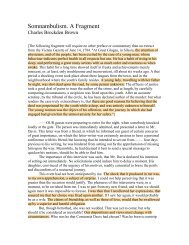Pt Two
Pt Two
Pt Two
You also want an ePaper? Increase the reach of your titles
YUMPU automatically turns print PDFs into web optimized ePapers that Google loves.
UNIT NINE: Late Baroque and Rococo STUDY GUIDE<br />
D Giovanni Battista Tiepolo. The Banquet of Cleopatra (Palazzo Labia, Venice), 1746-50, fresco<br />
Giovanni Battista Tiepolo/ Antony and Cleopatra/ a pearl for dessert/ luxury and the Labia family in Venice/<br />
Tiepolo and Mengozzi Colonna / trompe l‟oeil architectural details<br />
1. “The ceilings of Late Baroque palaces sometimes became painted festivals for the<br />
imagination. The master of such works, Giambattista Tiepolo (1696-1770), was the last<br />
great Italian painter to have an international impact until the twentieth century” (Kleiner,<br />
Mamiya, and Tansey 780). Between 1746 and 1750, Tiepolo and his assistants decorated a<br />
banqueting-hall for the noble Labia family in Venice. The work, covering 500 square meters, tells the<br />
story of Cleopatra. In this particular fresco, “spellbound, the assembled guests gaze at a woman<br />
about the redeem a wager. Cleopatra VII, Queen of Egypt, had boasted the Roman general, Antony,<br />
that she could devour a hundred times one hundred thousand sesterces at one meal… The Roman<br />
author Pliny the Elder, writing during the first century after Christ, had described the scene in his<br />
Natural History. Cleopatra, according to Pliny, had served up a banquet which, though sumptuous,<br />
amounted to little more than one of their everyday meals. Seeing this, Antony had merely laughed<br />
and asked to see the bill. Cleopatra had then assured Antony that he had seen no more than the<br />
trimmings, whereas the feast to come would certainly cost the agreed amount. She had then ordered<br />
dessert. However, the servants had placed before her only a single dish, filled with vinegar,<br />
whereupon the queen had removed one of her earrings, dipped it into the vinegar, let it dissolve, and<br />
swallowed it” (Hagen and Hagen, What Great Paintings Say 1: 116).<br />
2. “Tiepolo‟s contemporaries were probably in a better position than Pliny to appreciate Cleopatra‟s<br />
lifestyle. The Venetian Republic had lost most of its political and military power by the 18 th century.<br />
At the same time, its citizens attempted to make up for their sense of loss by squandering the vast<br />
wealth they had accumulated during their glorious past… During the 17 th century, when the<br />
maritime republic had been desperate for money to fight the Turks, the Labia had used the<br />
opportunity to buy their way into Venice‟s exclusive patrician circles. A legendary act of extravagance<br />
won them a mention in the annals of the town: at the climax of a banquet for 40 persons, a Labia, expressing violent contempt for all<br />
material possessions, had commanded the golden plates from which the guests had just finished eating to be thrown out of the window<br />
into the canal. In choosing the extravagant Egyptian queen as the subject of their banquet hall frescoes, the Labia were attempting to<br />
establish their own, admittedly rather tongue-in-cheek relation to tradition” (118). “But all that glitters is not gold… Thus it is said that<br />
the Labia recovered their costly plates by means of underwater nets stretched out in front of the palazzo. As for Cleopatra, chemistry had<br />
proved that pearls do not dissolve in vinegar!” (118) “The naturalist Pliny gives pearls the highest place among all things of value, but he<br />
also accuses the „family of shells‟ of thereby encouraging indulgence and moral degeneracy… Such are the thoughts of a strict moralist<br />
who cherished plainness and severity, the virtues of a male-dominated, highly militarized society. The Romans castigated luxury, selfindulgence<br />
and extravagance” (118).<br />
3. “In Tiepolo‟s day, a Labia widow and her two sons lived in the palace. De Brosses describes here as a woman who, though no longer<br />
young, „was once very beautiful, and had many love affairs.‟ Like the Egyptian queen, she had a famous collection of jewels which she was<br />
proud to show to visitors. Tiepolo would often make flattering allusions to his patrons in his paintings. His majestic portrait of Cleopatra<br />
may therefore bear some resemblance to the lady of the house” (119). “The master and his assistants appear in the background as<br />
discreet observers of the banquet they have painted… The man with the roundish face is said to be Girolamo Mengozzi Colonna (c.<br />
1688-1766), an expert in painting architecture… The entire, sumptuous majesty of the stately room is a masterpiece of trompe l’oeil”<br />
decoration” (120).<br />
4. “The Labia family would have been rich enough to panel their banqueting-hall with real marble if they had wished, or to decorate it with<br />
solid marble columns. It is possible, in any case, that this would have proved cheaper. But they were probably more fond of illusion than<br />
reality. After all, there were marble columns everywhere in Italy, whereas Tiepolo‟s architectural illusions were something quite exclusive:<br />
a highly skilled and baffling artifice which amused visiting spectators… Walls paneled with real marble might have demonstrated wealth,<br />
but they could never have achieved what Tiepolo and Mengozzi enacted with such apparent ease: the extension of space into an<br />
imaginative seascape under a vast evening sky” (121). “Tiepolo‟s contemporaries, it seems, were only too happy to retire from the gray<br />
demands of reality. Angelo-Maria Labia, for example, the widow‟s eldest son, became an abbé- a very worldly ecclesiastic – in order to<br />
escape the troublesome duties of a Venetian noble. As an abbé, he was not required to take office, but could devote his time to renovating<br />
palaces, collecting paintings and commissioning frescoes. His contemporaries spent their time at the theatres, opera houses or the<br />
carnival, and aristocratic tourists from all over Europe came to Venice to partake in what was essentially a non-stop orgy of escapism”<br />
(121).<br />
5. “The table for Cleopatra‟s banquet is laid out in front of a portico, behind which the sails of the Roman fleet are visible. The somewhat<br />
static ordering of the main figures is relaxed by the ironic positioning in the foreground of the little dog and the dwarf, who drags himself<br />
with difficulty up the steps towards the table. Cleopatra‟s exposed décolleté is meant as a reference to the by now advanced stage of her<br />
relationship with Anthony. In contrast to the Melbourne picture, the erotic and witty interpretation of historical events is given<br />
prominence over the festive setting itself” (Eschenfelder 64). “The Labia family were of Spanish origin and had only recently joined the<br />
Venetian patriciate. Tiepolo‟s frescoes reflect the family‟s great desire to create an impression: they are the greatest secular decoration he<br />
ever produced in Venice. The great hall of the palace, which rises up two storeys, is entirely covered by frescoes” (64, 67). “The musicians<br />
on the balcony in the background are an extension of the banqueting scene. Yet, like the fictive architecture, they could just as well be<br />
part of the courtly celebrations taking place in the Palazzo Labia itself” (67).<br />
22

















